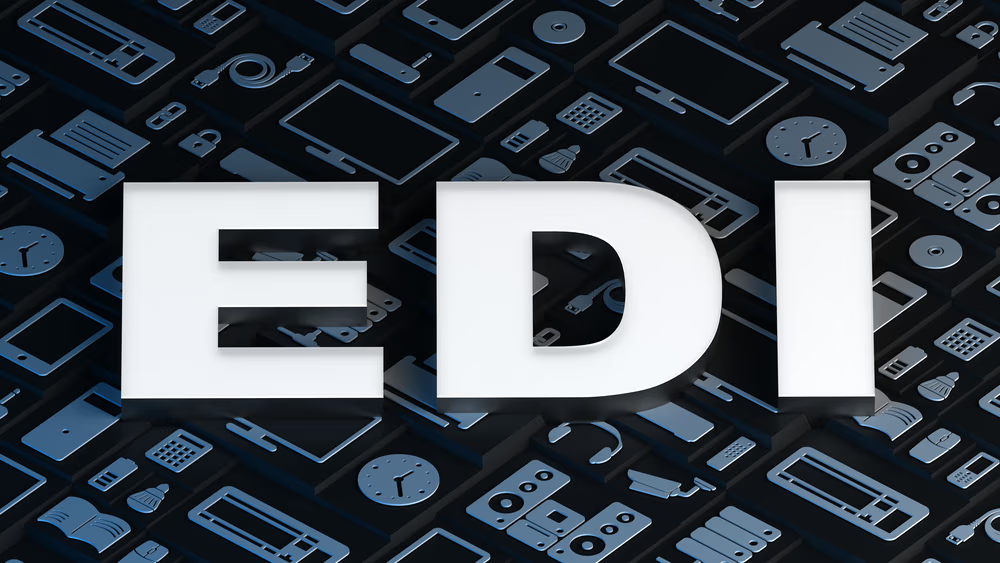Discover the pros and cons of six different types of EDI systems and learn which protocol best suits your business’s immediate needs.
An overwhelming majority of EDI software is custom-built, but bespoke software isn’t right for everyone. Exploring standardized types of EDI can help you choose the right platform for your business’s needs. You might even save money and improve transaction speed in the process.
If you’re considering electronic data interchange (EDI) to upgrade your electronic communications and organize essential documentation, such as purchase orders, invoices, and remittance advice, our review of the software will help you decide.
6 Types of EDI

There are multiple EDI systems that help business partners establish reliable connections. Here’s a look at some of the most popular contemporary EDI methods, their relative pros and cons, and recommendations on their ideal use cases.
1. Direct or Point-to-Point EDI
Direct EDI is also known as point-to-point EDI because it comprises a single pathway connecting two collaborators. Rather than sending one message to a portfolio of vendors, it’s simply going from point A to point B and back again.
Pros: Direct EDI is relatively simple and streamlined. A standardized, single-relationship connection helps businesses focus on EDI transactions with one vendor/receiver. It also lets the owner completely control the platform with little reliance on third-party assistance.
Cons: Point-to-point EDI can’t manage multiple accounts under the same operational umbrella, so it’s not helpful for companies looking for better ways to juggle a growing vendor portfolio.
Best for: Businesses that primarily invoice or order from one supplier, with lots of daily transactions and an agile internal team to tackle issues as they pop up.
2. EDI via VAN
Value-added networks (VAN) predate the internet, although today’s setups are far more streamlined and functional than old-school versions. EDI via VAN offers lots of connections with tons of privacy. The main network provider gives each company their own mailbox to send various EDI document types, such as invoices, and receive files in return.
Pros: The added security offered by VAN is a boon for businesses in sensitive industries, such as healthcare and fintech, where HIPAA compliance and/or privacy are vital. Organizations can also piggyback off the VAN’s existing partner connections rather than build their own infrastructure.
Cons: EDI via VAN users are reliant on third-party connections and software. There are also fewer options for personalization and customization. One common concern regarding VAN is its perceived "black box" nature, which results in limited visibility and control over delivery processes.
Best for: This EDI system is ideal for growing companies that manage multiple suppliers but don’t yet have the capabilities or desire to build a proprietary network.
3. EDI via AS2
AS2 stands for “Applicability Statement 2,” an EDI alternative that operates over networks running the TCP/IP protocol. For AS2 to work, both the sending and receiving companies must be online 24/7, with round-the-clock availability for communication and transmission-related troubleshooting.
Pros: EDI via AS2 is secure and reliable — so much so that many of the world’s largest retailers rely on this system to manage millions of EDI files, invoices, and vendor messages. AS2 systems put important data in a digital envelope of sorts, securing the user info inside with digital certificates and encryption.
Cons: AS2 requires all users to be online continuously, which may be problematic for businesses with unreliable internet connections or other issues that make 24/7 connectivity untenable. Messages sent when the recipient is offline don't go to an inbox or other holding space. They’re lost with no alert or record, which can lead to confusion and issues with orders, invoices, payments, and inventory.
Best for: Companies that want a safe, affordable, and fast way to automate and manage server-to-server file transfers without setting up pricey and cumbersome in-house systems.
4. EDI via FTP/VPN, SFTP, FTPS
These EDI communication protocols all help facilitate direct exchanges. File transfer protocol (FTP) is one of the earliest file exchange methods used by tech-driven businesses, and it lacks proper security coverage unless paired with a virtual private network (VPN).
As the names suggest, secure file transfer protocol (SFTP) and file transfer protocol secure (FTPS) offer extra security by encrypting data during transfer.
Pros: Adding layers of security to transmissions protects companies on both sides of every transaction and communication, ensuring sensitive information doesn’t fall into the wrong hands.
Cons: These protocols don’t offer receipt confirmations, so many companies use them in conjunction with an EDI provider with its own message management system and other crucial functionalities.
Best for: Companies that prioritize privacy and security and either don’t care about receipt confirmations or have a separate way to verify message delivery.
5. Web EDI
With web EDI, companies conduct EDI transfers using browser-based forms that mimic pre-internet paper forms. This method often incorporates other protocols, such as FTPS or AS2, for security’s sake. Although web EDI may seem primitive compared to more complex, independent EDI apps, this approach’s simplicity makes it more accessible to small- and medium-sized businesses with limited resources.
Pros: Browser-based web EDI doesn’t require expensive operating systems or tech upgrades for users. This increases access and evens the playing field, allowing small businesses and startups to get in on the EDI game from the get-go.
Cons: Web EDI’s simplicity may not meet the needs of companies that monitor dozens or even hundreds of invoices and orders daily.
Best for: Companies that only need to access EDI occasionally and prefer not to invest a lot in a system they’ll rarely use.
6. Mobile EDI
Mobile EDI refers to EDI applications developed for and used on mobile devices, such as smartphones and tablets. This new and growing market aims to help businesses monitor and manage their supply chain transactions from anywhere, at any time.
Pros: Supply chain management assistance is in the palm of your hand — a massive benefit for productivity. It makes it easy to send invoices and promptly respond to time-sensitive messages, even when you’re out in the field.
Cons: Because mobile EDI is relatively new, some apps may be less robust or comprehensive than browser- and PC-based alternatives.
Best for: Businesses willing to sacrifice some functionality in favor of convenience and on-the-go access.
Implementation of EDI

Once you’ve decided how to transfer information to your business partners, it’s time to focus on EDI integration — a potentially frustrating process due to an ever-evolving checklist of regulatory, formatting, and tech requirements.
A basic but effective EDI implementation may include the following:
- Trading partner agreements (TPA): A TPA is a contract between trading partners that outlines terms and conditions and defines agreed-upon standards and protocols. This step is vital for improving EDI compliance.
- Translation or EDI mapping software: This software maps and transfers identifying data (e.g., names, addresses, part numbers, and financial details) from one document type to another.
- Enveloping functionality: For EDI software that uses “envelopes” to package and transmit batched data, enveloping capabilities form the cornerstone of most transactions. They’re also useful for organizing communications used in EDI transactions according to a business division or industry.
- Messaging: Your EDI must be able to sort and format messages so they’re in the ideal deliverable form.
Talk to an Orderful expert to see which EDI is right for you
What distinguishes API versus EDI? Do you need your own network, or is it safe to partner with an existing one? There are many types of EDI with significant crossover in setup and functionality, making it difficult to know which system is right for your business.
Fortunately, Orderful is here to help you connect to your trading partners, regardless of how they trade EDI. Reach out and speak to an expert for more information about EDI’s benefits and to learn how we simplify EDI integration so you can reap the rewards of streamlined supply chain management in record time.
Interested in learning more about EDI? Whether new to EDI or looking to deepen your knowledge, LearnEDI.org is here to help you understand how EDI can improve your operations

